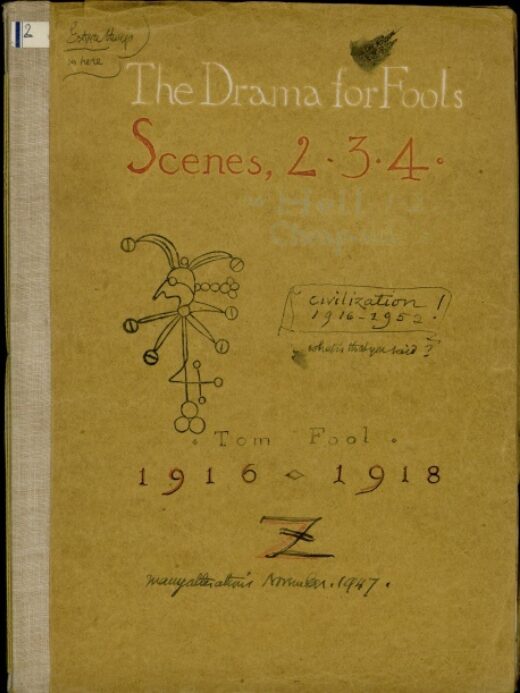
Printed
11 pages
Author(s)
Hell (1918)
3rd version
The Drama for Fools is a long theatrical cycle containing multiple interludes. This cycle kept Craig very busy between 1916 and 1918. It was supposed to hold 365 short plays and be performed like a traveling show: each night, from April 1st to March 31st, a new play was to be performed in a new location. Craig, who signed his plays under the nickname Tom Fool, stopped writing before the cycle was finished and gave up on performing the play himself. Nonetheless, he managed to keep his drafts in three cardboard boxes, as a collection of typewritten notebooks containing a myriad of illustrations and whose covers were calligraphed in different colors. He cared immensely for these notebooks: he improved, corrected, and added material to them until the 1950s. Nowadays, this collection belongs to the International Puppet Institute (Institut International de la Marionnette), based in Charleville-Mézières.
Hell is the real beginning of the main plot line, that is to say, the story of Cockatrice (the Basilisk), who is turned into the embodiment of the ultimate evil: hypocrisy; this beginning was supposed to shape all of the Drama for Fools. In 1916, after multiple false starts with different characters, the cycle transforms into a journey through history, until the present time. The goal was to show the mistakes made by Cockatrice in all eras. Craig is so fascinated and entertained by his character that he gives him two sidekicks: Blind-Boy and Columbus the Parrot (aka Pretty Polly). He stages them in a series of comical adventures, but these do not last long, as the author prefers the numerous satirical interludes drawing from other inspirations and staging other characters.
Just like Pulcinella, Cockatrice was born from an egg, but the egg was laid by Jove, who had turned into a rooster to avoid Juno’s watch. Cockatrice looks like a worm, wears a hat, speaks in a cockney accent, and, just like Blind-Boy, is from St. Mary le Bow, a working-class district from which the cockney accent originates.
This part of the Drama for Fools began with many unfinished drafts presenting different versions of the story. In this third version, which dates back to April 1918 and was corrected and expanded until the 1950s, the action begins directly in Hell, as the play follows the interlude The Gates of Hell. Two years before, in spring 1916, Craig had chosen to start the play with a domestic quarrel between Jove and Juno.
The birth of the embodiment of evil
The play begins in Hell: a small bedroom in an apartment in Cheapside, London. Pluto, the God of Hell, is an old man in a dressing gown and slippers who sleeps in his armchair while angel-faced devils sing him a lullaby. He is awakened by the announcement of the arrival of two visitors. Before they enter, Pluto orders the place to be changed in accordance with the expected aspects of Hell: cauldrons, damned souls, flames, and devils.
The two visitors, Blind-boy and Pretty Polly the parrot, are introduced to Pluto and his favorite snake, Slimy-Go-Gurgle-and-Twirl. They are sentenced to boil in the cauldron of Hell, but Pretty Polly states that it has a gift for Pluto in its bag. Pluto asks to see it. The gift is an egg containing six others, all of different colors and set one into the other. The “Worm of worms”, Cockatrice, hatches from the smallest, killing all the snakes of Hell and frightening everyone. Pluto gifts his ring to Blind-Boy so that he can take Cockatrice away, but Blind-Boy informs him that he is his mother and offers to share how it came to be. They all sit in front of a small theater where the story of Cockatrice’s birth is narrated.
In the cockney neighborhood of London, Jove, dressed up as a rooster, enters Blind-Woman and Blind-Boy’s shop in order to buy pigeon milk. He hands over an egg to Blind-Boy, who is blind and cannot see that Cockatrice is ready to hatch. As the sight of Cockatrice is dangerous—it would even be fatal for him to see himself in a mirror—Jove asks Blind-Boy to be Cockatrice’s mother and to never reveal to him who his father is. After hatching, Cockatrice befriends Blind-Boy, and they decide to travel the different worlds together.
After the performance ends, Blind-Boy, Cockatrice, and Pretty Polly leave Hell in order to save Hercules from the snakes sent by Juno.
Other titles
Publications and translations
Edward Gordon Craig, The Drama for Fools / Le Théâtre des fous. Montpellier: L'Entretemps, 2012.
Edward Gordon Craig, The Drama for Fools / Le Théâtre des fous. Montpellier: L'Entretemps, 2012.
(French)
